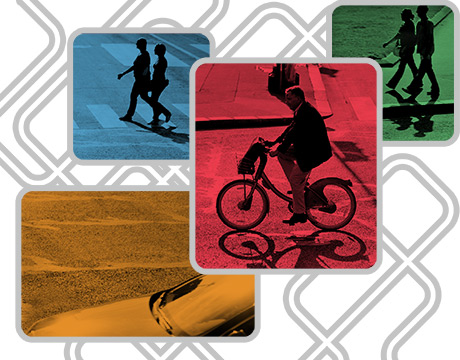Give Us the Freedom to Walk, Bike or Drive
Give Us the Freedom to Walk, Bike or Drive


There’s an old joke about people who drive a mile to the gym so they can walk two miles on a treadmill, but it is true that Americans typically don’t travel from place to place on foot.
That’s not an indictment of laziness. The choice of getting around any way other than by petroleum-powered automobile has been taken away from most Americans.
Join ASME and Leading Industry Experts for Offshore Wind Turbine Webinar series
Here’s an anecdote from my own personal experience. While my architect wife was remodeling our home, we rented a house a few blocks from the local elementary school. We were so close that we could have enjoyed the daily ritual of walking together to the school. Unfortunately, walking was not an option. There wasn’t a sidewalk along the busy road or a protected way to cross the streets safely. Sure, there was a crossing signal at the light, but no sidewalks on either side, so we would have had to walk in a ditch along a five-lane highway and stand in mud while waiting to cross.
Instead we had to get in our car and drive those few blocks just for our own safety, consuming more energy and spewing more emissions along the way, only to wait in a long line of cars with other parents dropping off their kids, tailpipes close to kids’ noses pumping particulate matter into their lungs.
This isn’t a good way to live.
Read ASME’s Top Story: Five Job Interview Questions Young Engineers Can Expect
Who’s responsible for this mess?
It’s easy to blame urban planners. By omitting protected bike lanes, sidewalks, pedestrian-friendly crossings, mass transit, and density, their plans have essentially required us to use cars. But the dominance of one mode of transportation—petroleum-powered automobiles—above all others is also due to conscious decisions made by homebuilders.
As Jace Deloney, a transportation expert based in Austin, Texas, noted via Twitter, modern houses are “designed like car-dominant cities. New homes often make the garage more prominent than the front door.”
When homebuilders erect subdivisions remote from public transit, they have decided for us that we will drive cars, since there are no alternative ways of getting around.
By not wiring or plumbing our garages for high-power charging or natural gas fueling, they have decided for us that we will drive gasoline or diesel-powered automobiles.
Listen to the latest episode of ASME TechCast: Breakthrough Could Bring New Cancer Treatment
It’s easy to imagine the alternative. If every garage in every home was built pre-wired and pre-plumbed for home charging and fueling, consumers would have more options about the type of car and fuel they use. Buying an electric or natural gas-powered vehicle wouldn’t require hiring a contractor on top of choosing a car.
Ultimately, it’s crazy that home builders choose our transport for us. But that could be easy to fix with building codes and planning policies. Designing houses that accommodate different transportation modes—pre-wired and pre-plumbed for non-petroleum cars and maybe with a bike rack, too—is an important complement to designing livable, walkable cities that don’t prioritize cars.
Our homes and buildings are the ultimate durable goods, lasting decades or centuries. And by one estimate, the world will need to add 2 billion homes over the next 80 years to account for population growth. Since new homes will be with us for a long time, building them with transportation and energy flexibility in mind will help us meet challenges we know about, such as climate change, and adapt to those that we haven’t yet imagined.
More on Energy Policy from Michael Webber: U.S. Can Learn From Texas’ Surge in Wind and Solar Power
To get there, Americans will have to reframe their notions of independence. The idea that unknown faraway bureaucrats or hidden corporatists would make decisions for us gets our hackles up and underpins the modern political rivalry between parties who strive to protect us from the oppression of either big government or big business. Self-reliance and the freedom to chart our own course is a definitive aspect of United States culture.
While the arrival of cars in post-WWII America typified freedom because they let us move to the suburbs and roam the country, we now have become trapped in car-dominated cities and homes. It’s time we take the power back into our hands from homebuilders and city planners.
We should demand more freedom, which means more options for movement.
Michael Webber is the Josey Centennial Professor of Energy Resources at the University of Texas in Austin and Chief Science and Technology Officer at ENGIE, a global energy company headquartered in Paris.
Register today for ASME’s Offshore Wind Summit to learn about the latest technologies, opportunities and supply chain strategies from leaders in the oil, gas and wind energy industries.
Read Latest Exclusive Stories from ASME.org: 6 Ways Engineers Heal a Broken Heart Shrinking an Exhaust Resonator for New Automotive Design Game Theory Helps Robot Design




